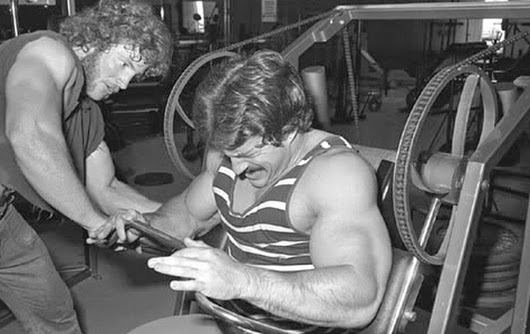For several decades now, mainstream health and fitness authorities have recommended aerobic exercise, also known as endurance exercise or “cardio”, as the best way to exercise and get fit. And Americans have been following that advice, and now exercise more than ever.
As with the universal recommendation to eat low-fat foods, the advice to do aerobics was given starting right around the time that the obesity epidemic got going. Most knowledgeable people (such as, ahem, myself) believe that the low-fat craze and the obesity epidemic are intimately related. What about aerobics – could that have contributed to the obesity epidemic too? Could be.
Muscle loss with aging
As humans get older, they lose muscle at a predictable rate if they don’t do anything about it. Between ages 50 and 70, most people will have lost 30% of their muscle mass, and then another 20% or so to age 80, a full half of all muscle being lost by that age.
The loss of muscle is largely responsible for the fact that most people gain fat as they get older, even when eating the same quantity and quality of food as when they were younger; muscle burns more energy than other tissues, so when it’s lost or replaced, total metabolic rate declines, and if food intake doesn’t also decline, fat gain ensues.
Two things can help prevent muscle loss with aging: a higher fraction of protein in the diet, and strength training. (High doses of testosterone, anabolic steroids, or growth hormone work too.)
Aerobic exercise does next to nothing to fight muscle loss. Walking is probably the most common form of aerobic exercise that people engage in, and if someone did nothing but walk, they will typically lose 4 to 6 pounds of lean mass every decade, along with a decline of 2 to 3% in resting metabolic rate, essentially no different than if that person was completely sedentary.(1)
So aerobics, or at least walking, could lead to fat gain by allowing the loss of muscle mass.
Would more intense forms of aerobics be better than walking for retaining or building muscle? That seems doubtful: I’ve never seen a well-muscled distance runner. (Sprinting is another story, of course, but that isn’t aerobic exercise; it’s high-intensity training.)
Dieting and aerobic exercise
People of course use aerobic exercise to try to lose fat, even though it has a poor record in this area. Mostly people try to lose weight with a combination of low-calorie dieting and exercise together, and this combination is astoundingly good at one thing, and that’s causing the loss of muscle.
A rule of thumb when dieting for weight loss if that from one fourth to one third of weight lost is muscle. That’s not good and should be avoided.
Some researchers looked at what would happen when a group of 20 people (3 men, 17 women) were randomly assigned to diet and exercise. One group of 10 did aerobics, one hour, 4 times a week, and it consisted of walking, cycling, or stair climbing. The other group did resistance training, 10 different stations, starting at 2 sets of 8 to 15 reps, increasing to 4 sets of the same by week 12. Both groups were placed on a low-calorie diet, at 800 calories. The program lasted 12 weeks.(2)
The diet + aerobics group lost 18 kg (about 40 pounds) but, too bad for them, 4 kg (9 pounds) of that was muscle.
The diet + resistance training group lost 14.4 kg (32 pounds), and all of that was fat. They lost no muscle.
Resting metabolic rate decreased in the diet + aerobics group, and increased in the diet + resistance training group.
Which group do you think looked better, felt better, and had better prospects of maintaining their fat loss? That’s right, the resistance training group.
The resistance training group didn’t even work out as hard as they could have, and used no added protein. If they had done both, they likely would have gained muscle while they lost fat.
The important lesson here: if you want to lose fat and do so by dieting, resistance training (weightlifting, strength training) should always accompany your efforts, or you stand to lose muscle.
Aerobic exercise, especially when combined with dieting, can lead to muscle loss, resulting in lower metabolic rate and worse health, not to mention an increased risk of sarcopenia. Some studies have found that losing fat as measured by waist size results in lower mortality, but a decline in body mass index (BMI) raises mortality risk. (3) The explanation here is that losing fat is good, losing muscle is bad. Very bad.
Basically, the mainstream health and fitness establishment was wrong again, like they were with low-fat eating. While aerobic exercise does have benefits for cardiorespiratory fitness, it does little to nothing to prevent muscle loss and besides that, is an inefficient way to train. Running causes more injuries than bodybuilding.(4)
I’ve explored many variations on the theme of aerobics versus strength training in my new book, Muscle Up: How Strength Training Beats Obesity, Cancer, and Heart Disease, and Why Everyone Should Do It.















15 Comments
Not to be a one upper, but my strength training goes MUCH better when I combine it with “cardio”. I think there are two factors that make doing cardio beneficial
1) I use an airdyne, so it is extremely low-impact and basically aides my recovery.
2) I use a HRT monitor – so I am able to titrate the dose of aerobic exercise with some precision. I am typically shooting for 40 minutes at a hrt of 128 (180 – my age) three times a week.
Doing this exercise regimen has for the first time given me the major benefits (IMHO) of a low carb diet (low trigs and high HDL)
Peace
Joe E O
Thanks, Joe. From what you’ve said before you seem very athletic, and this adds to that. You seem to be doing a large volume of exercise.
Methinks Joe might be even better off if he used interval training instead of cardio. Most stationary bikes at fitness centers have built in interval programs.
Clarence Bass has an interesting article on combining weight training and aerobics on the same day. Didn’t seem to negatively impact protein synthesis at all.
https://www.cbass.com/Weights_Aerobics.htm
Would you say that walking is better than no excersice att all?
Yes. If you can, throw in some bodyweight exercise: pushups, pullups, squats etc.